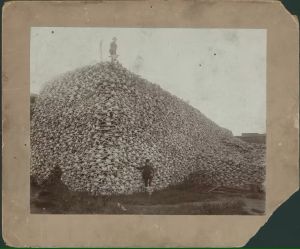Pte Oyate
Tȟatȟáŋka Genocide
See: Red Meat Republic; Oceti Sakowin; Indigenous Food Sovereignty; Traditional Ecological Knowledge
It all started in the 19th century when herds of 4 million American bison lived in the Great Plains and provided significant resources for the people that thrived there – such as food, medicine, clothing, shelter, tools, utensils, decoration and playthings. The buffalo was so valuable that the people of the Great Sioux called themselves Pte Oyate (Buffalo Nation) and stories of creation emerged detailing the buffalo using its nose to create a human from a pile of mud.[1]
North American Buffalo populations are estimated to have been in the 30-50 millions before European contact.[2] Generals William T. Sherman and Philip Sheridan spearheaded the military tactic of en masse slaughter of the buffalo in an attempt to "civilize" Indigenous Nations across the plains: "On 26 June 1869, the prestigious Army-Navy Journal reported that 'General Sherman remarked, in conversation the other day, that the quickest way to compel the Indians to settle down to civilized life was to send ten regiments of soldiers to the plains, with orders to shoot buffaloes until they became too scarce to support the redskins.'"[3]
Soon, it became the norm for Sherman and Sheridan to provide opportunities for the rich and influential to travel West and hunt Buffalo with U.S. Cavalry guns alongside prominent generals like General William F. Cody (Buffalo Bill Cody), who claimed to kill 4,000 Buffalo himself. "In fact, the Springfield army rifle was initially the favorite weapon of the hide hunters. The party killed over six hundred Buffalo on the hunt, keeping only the tongues and the choice cuts, but leaving the rest of the carcasses to rot on the plains."[4]
In a fifty-five-year period, 1830-1885, soldiers, hunters, and settlers killed more than 40 million Buffalo.
For millennia to follow, the tribes moved wherever the buffalo migrated. People among the tribes were well fed and no one ever got sick. That was until the Europeans colonized the Lakota territory and destroyed the culture that surrounded the buffalo. The mercenaries slaughtered millions of buffalo and the self-sufficient nature of the tribes ceased .After several years, the people were introduced to processed and canned carbohydrates, fats, salts, sugars, and preservatives. “Our warriorhood was lost when we accepted the food”. And, not only was the warriorhood lost, but public health issues began to arise such as heart disease, high blood pressure, obesity – and they still remain today.[5]
The genocide of the Buffalo completely ruptured the means to sustenance of the Oceti Sakowin, and altered their way of life permanently. The decimation of the buffalo is only but one example of the ways the United States government plotted and executed plans to disrupt Indigenous Nations sustainable symbiotic relationship with the land and all creatures they shared it with.
Sources
- ↑ https://www.cwis.org/2020/07/buffalo-are-the-backbone-of-lakota-food-sovereignty/
- ↑ Dunbar-Ortiz, R. (2015). An indigenous peoples' history of the United States. Boston, Beacon Press.
- ↑ https://blog.nativehope.org/how-the-destruction-of-the-buffalo-impacted-native-americans
- ↑ https://blog.nativehope.org/how-the-destruction-of-the-buffalo-impacted-native-americans
- ↑ https://www.cwis.org/2020/07/buffalo-are-the-backbone-of-lakota-food-sovereignty/
